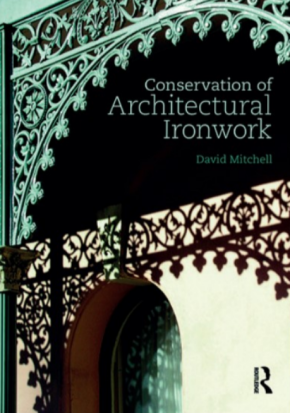Conservation of Architectural Ironwork

|
| Conservation of Architectural Ironwork, David S Mitchell, Routledge, 261 page, black and white illustrations with some colour plates, hardback. |
The last 20 years has seen a renewed appreciation of architectural ironwork, particularly that of the Victorian period. This has been partly driven by funding programmes such as the Heritage Lottery Fund’s Parks for People programme. Investment in urban parks which contain many fine iron structures, from bandstands to glass-houses, fountains to gates, has been significant. It is in this context that David Mitchell has produced his timely publication ‘Conservation of Architectural Ironwork’.
Starting with a history of iron, its manufacture and use architecturally, the book then describes the varied types, their chemical and physical properties, their weaknesses and decay mechanisms. It dispels many oft-perpetuated myths regarding iron (cast and wrought) and steels. Mitchell effectively combines technical and scientific information with practical descriptions and a clear narrative history.
The book covers the diverse and ever-evolving manufacturing processes and the development of alloyed materials, through to common weaknesses and even manufacturers’ tricks to conceal defects in poor-quality castings. The most infamous example is the use of Beaumont’s Egg (a composition of beeswax, fiddler’s rosin, iron borings and lamp-black) in the casting and manufacture of the Tay Bridge near Dundee, which consequently collapsed in 1879. An excellent overview of the survey of iron structures provides practical advice on the application of a variety of survey techniques to identify different materials and make diagnostic assessment of defects. It highlights the potential pitfalls and illustrates how easy it is to make erroneous assumptions.
Unusually for a technical conservation publication, the robust management of a project and its material effect on the outcome are given a significant weighting. This is both refreshing and helpful. The conservation practitioner, in any field, would do well to read the sensible processes outlined. The book acknowledges the reality of working in a procurement-led, cost-driven environment, and provides a sound methodology to achieve good conservation outcomes.
Mitchell addresses the philosophical and technical challenges faced when conserving an iron structure. From the removal (or not) of surface finishes to wide-ranging corrosion issues, the principles of repair and the inherent challenges of different types of iron are covered in detail and cross-referenced to practical examples. As with most conservation work, there is rarely a definitive right answer, but Mitchell paints a clear picture and establishes a robust framework within which to make decisions.
The narrative on fixings and their appropriateness is particularly interesting, balancing the technical, philosophical and aesthetic rationale for using traditional or modern fixings in particular contexts and environments. The illustration of the factors to be considered when joining different metals and the consequent potential specifications are invaluable. Following a discussion on the relative merits or weaknesses of different coating systems, traditional and modern, Mitchell effectively illustrates the themes of the previous chapters with a series of detailed case studies.
Throughout the book the descriptive text is supported by well-considered and appropriate examples and illustrations. It is entirely appropriate that the book uses Scottish examples extensively (Mitchell is director of conservation at Historic Environment Scotland) as the great Scottish manufacturers were leaders both in the global market place and in technological innovation.
A well-thumbed copy of ‘Conservation of Architectural Ironwork’ should be found on the shelves of all conservation practitioners. The philosophically robust, yet practical approach not only provides a sound framework for the conservation of iron structures, it has a much wider potential application as a benchmark for developing approaches to the conservation of modern component-based buildings.
This article originally appeared as ‘Hard lessons’ in IHBC's Context 157 (Page 61), published in November 2018. It was written by Robert Chambers, director of Chambers Conservation, Chester.
--Institute of Historic Building Conservation
Related articles on Designing Buildings Wiki
- Cast iron.
- Code of Practice for Ironwork Systems Installation and Refurbishment.
- Conservation.
- Difference between cast iron and wrought iron.
- Failure of cast iron beams.
- IHBC articles.
- Iron.
- Iron frames in textile mills.
- Ironwork.
- Steel.
- The Institute of Historic Building Conservation.
- Wrought iron.
IHBC NewsBlog
Images from inside a Grade II listed hotel show the scale of its collapse
The Corbett Arms in Tywyn has fallen into serious disrepair.
Old Sarum fire in listed (& disputed) WW1 Hangar - Wiltshire Council has sought legal advice after fire engulfed a listed First World War hangar that was embroiled in a lengthy planning dispute.
UK Antarctic Heritage Trust launches ‘Virtual Visit’ website area
The Trust calls on people to 'Immerse yourself in our heritage – Making Antarctica Accessible'
Southend Council pledge to force Kursaal owners to maintain building
The Council has pledged to use ‘every tool in the toolbox’ if urgent repairs are not carried out.
HE’s Research Magazine publishes a major study of the heritage of England’s suburbs
The article traces the long evolution of an internal programme to research 200 years of suburban growth
IHBC Context 183 Wellbeing and Heritage published
The issue explores issues at the intersection of heritage and wellbeing.
SAVE celebrates 50 years of campaigning 1975-2025
SAVE Britain’s Heritage has announced events across the country to celebrate bringing new life to remarkable buildings.
IHBC Annual School 2025 - Shrewsbury 12-14 June
Themed Heritage in Context – Value: Plan: Change, join in-person or online.
200th Anniversary Celebration of the Modern Railway Planned
The Stockton & Darlington Railway opened on September 27, 1825.
Competence Framework Launched for Sustainability in the Built Environment
The Construction Industry Council (CIC) and the Edge have jointly published the framework.














